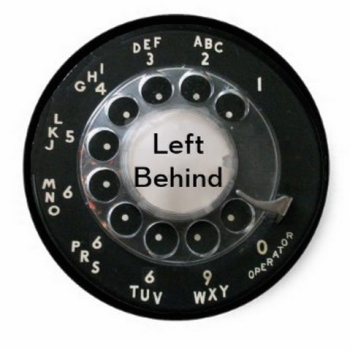“Backwards B Watch” is the title of Josh Marshall’s post linking to this story from Texas. The reference there is to a story you may remember from back in 2008 involving an innocent person brutally attacked by an angry mob of Obama supporters near Pittsburgh just weeks before the presidential election. The attackers had savagely carved the letter B — for “Barack,” apparently — in their victim’s face.
 That story was hyped by the Drudge Report and by Fox News, but quickly fell apart when it turned out that none of it was true. There was no angry mob of Obama-supporting savages and there was no attack. The “victim” who reported the attack was not a victim — and she admitted the whole thing was a hoax after police were unable to find any corroboration for her story in security video. Police were initially suspicious of her claims, in part, because the B cut into her cheek was backwards — the result of doing that to herself while looking in a mirror.
That story was hyped by the Drudge Report and by Fox News, but quickly fell apart when it turned out that none of it was true. There was no angry mob of Obama-supporting savages and there was no attack. The “victim” who reported the attack was not a victim — and she admitted the whole thing was a hoax after police were unable to find any corroboration for her story in security video. Police were initially suspicious of her claims, in part, because the B cut into her cheek was backwards — the result of doing that to herself while looking in a mirror.
The fact that a disturbed individual (she was later sentenced to court-ordered psychiatric counseling) would concoct such a story was dismaying, but not nearly as dismaying or revealing as the fact that millions of others were willing, able and eager to believe such a tale. Even more troubling is the way that such hoaxes take on a seeming-reality for many of those who first believed them. After their initial disappointment when this story was thoroughly and conclusively proven a hoax, the fall-back position for many of the Drudge-readers and Fox-viewers who wanted it to be true was to say that, OK, while this particular story was false, it still was believable because it fits with a larger pattern of such incidents, and that larger pattern is true.
That this supposed larger pattern consists entirely of similar hoaxes doesn’t diminish their faith in the truthiness of this larger pattern.
It’s a bit like the way that some older white people handle their encounters with many individual black people. Despite clinging to a host of fears and prejudices about “those people” as a whole, they can be warmly and genuinely friendly with most of the individuals they meet. (Thus, as they’re sure to remind you, they can truthfully say that they have “many black friends.”) They simply classify each of these individuals as “one of the good ones” — a rare and notable exception to the larger pattern. And it never seems to occur to them that every individual they’ve ever gotten to know was similarly “exceptional” — that all of the evidence contradicts the existence of this larger pattern, and none of that evidence confirms it.
I suspect we’ll see this same pattern repeated with this latest hoax: “Cops: Texas Man Vandalized His Own Truck, Blamed It On Black Lives Matter.”
A disabled veteran told Whitney, Texas, police on Sept. 8 that his pickup truck was vandalized by Black Lives Matter activists. As a result, he raised almost $6,000 from the public for repairs, according to a report from Dallas-Fort Worth television station KDFW.
But footage from the television station’s initial report told police a different story. On Friday police arrested Scott Lattin on suspicion of making a false police report.
Lattin told police that his truck, which he had painted with “Police Lives Matter,” was spray painted with “Black Lives Matter” and “Fuck Your Flag, Your Family, Your Feelings, Your Faith.”
Lattin eventually admitted to damaging the truck himself, for insurance reasons.
Once again, there was no attack carried out by a faceless mob of savage black people. And there was no faceless mob of savage black people.
But once again, there was an eager audience for the hoax — an audience once again disappointed to learn that none of it was true. They had initially embraced the story because, to them, it sounded like just the sort of thing they were sure that roving mobs of faceless savage black people would be likely to do.
And even though this particular story turned out to be a hoax, they remain convinced that it was believable because it fit the larger pattern of black criminality — a pattern attested to by scores of similar, equally credible stories.
But there’s another dynamic at work here — another even more preposterous form of doublethink that converts such hoaxes into evidence of the larger pattern. It’s a weird leap of illogic, a clumsy form of defensive self-deception, yet it seems to work for those who want or need to make it work. It goes like this:
1. Savagely attacking someone and carving letters into their face is a horrible thing to do.
2. Yes, perhaps that was just a lie in this particular case, but ask yourself: What’s worse? Lying? Or brutally attacking someone and carving letters into their face? Clearly, the brutal, face-carving attack is far graver and more serious an offense than merely telling a fib.
3. So why are you more upset about one little lie than about the brutal attack? Have you no sense of proportion?
That may seem too absurd to be anything that anyone could really do, let alone really be convinced was convincing. But they do, and they are. Right now. Millions of people are arguing exactly that — to others, but even more so to themselves.
Simply replace “attacking someone and carving letters into their face” with Carly Fiorina’s tear-jerking fantasy: “a fully formed fetus on the table, its heart beating, its legs kicking while someone says we have to keep it alive to harvest its brain.”
We are being told that it shouldn’t matter to us that Fiorina’s story has been debunked as a complete fabrication because what’s more important is the “larger pattern.” And we are being told that nitpicking about one little falsehood shows that we’ve lost our larger sense of persepective, because who cares about one little lie compared to the horrific evil of chopping up babies to sell their body parts?












